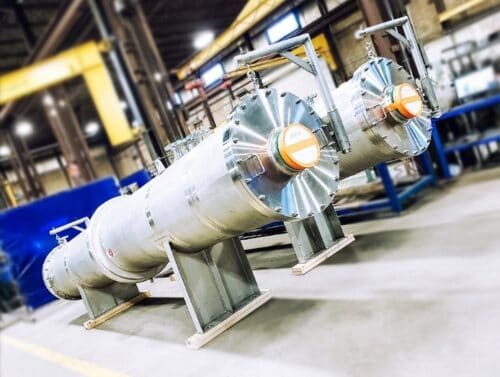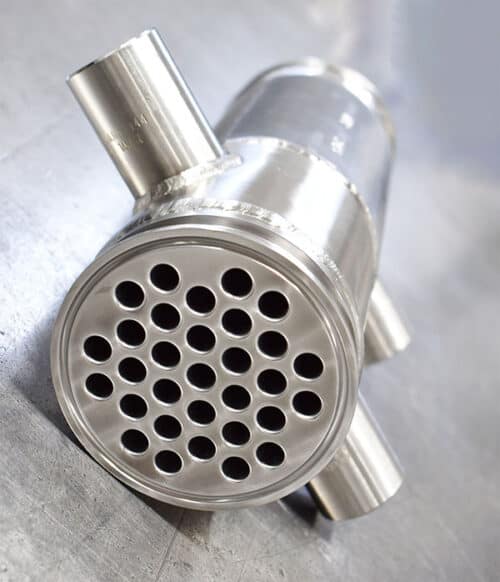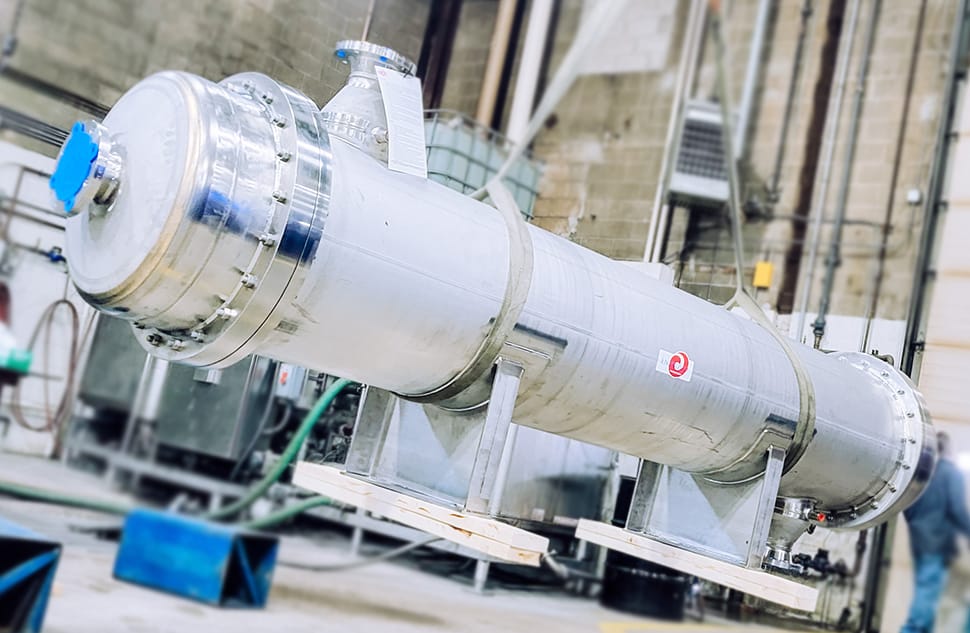When it comes to optimizing shell and tube heat exchangers, a multitude of factors comes into play. These elements wield significant influence over not just the size of the exchanger but also its performance, efficiency, and overall cost.
Think of it as a delicate equilibrium, where variables such as heat transfer rates, fluid flow velocities, and material properties converge to shape the final product. Enerquip specializes in unraveling this intricate puzzle, utilizing advanced calculations and simulations to engineer solutions tailored to your precise requirements.
In this blog, we’ll dive into the core components that dictate the sizing of shell and tube heat exchangers, shedding light on the meticulous craftsmanship that transforms complexity into streamlined functionality. Join us in uncovering the mechanics of optimized heat transfer, where Enerquip takes the reins and innovation takes center stage.
Variables That Impact the Size of a Heat Exchanger
Various factors can influence the sizing of a shell and tube heat exchanger. These factors can affect the heat exchanger’s overall performance, efficiency, and cost.
Thermal Attributes Affecting Heat Exchanger Sizing
Here are some of the key thermal and environmental variables that can impact the sizing of a shell and tube heat exchanger:

30” x 160” Resin Reactor Condensers
Fluid flow rates: The flow rates of both the hot and cold fluids significantly affect the sizing. Higher flow rates may necessitate larger heat exchangers to maintain heat transfer efficiency while minimizing pressure drop.
Desired temperature change: The desired temperature change of the process fluid (combined with its flow rate) determines the total heat transfer (BTUs/hour) required in the unit. A smaller temperature change, or an option to recirculate the process fluid until it reaches the desired temperature, can help reduce the size of the unit. Conversely, a large temperature change will typically lead to a larger exchanger.
Approach temperature: The approach temperature refers to the difference between the desired outlet temperature of one fluid and the inlet temperature of the other. A narrow approach temperature reduces heat transfer rates, requiring more surface area to achieve the desired heat transfer, typically increasing the size and cost. Conversely, a wider approach temperature improves transfer rates and typically allows for a smaller heat exchanger size.
Thermal fluid properties: The thermal properties of both fluids have a significant impact on heat exchanger sizing. First, the specific heat capacity indicates the amount of heat energy a fluid can carry, with higher heat capacities typically allowing for a more compact design. Thermal conductivity is a measure of the ability of a fluid to give (or receive) heat, with higher conductivity values typically reducing the unit’s required surface area (and size). Fluid density influences mass flow rates, which in turn impacts the sizing. Fluid viscosity is a measurement of a fluid’s resistance to flow. Fluids with high viscosity will tend towards laminar flow and lead to higher pressure drops, which may require a larger exchanger to compensate.
Design specifications: Design specifications like operating pressure and temperature can significantly influence the sizing of a heat exchanger. Higher operating pressures may require thicker materials which can negatively affect heat transfer (heavier wall tubes, for example). Elevated temperatures can also affect thickness and material selection in some cases, leading to a larger exchanger.
Pressure drop considerations: Pressure drop refers to the decrease in fluid pressure as it flows through the shell or tubes due to friction or changes in direction. It’s a crucial factor in fluid dynamics and engineering systems. In heat exchangers, pressure drop affects the efficiency of heat transfer and can impact the system’s overall performance. Higher pressure drop can result in increased energy consumption to maintain fluid flow and temperature differentials, often requiring larger equipment or adjustments to maintain desired operational conditions. Higher pressure drop demands increased flow area, leading to larger tubes or possibly a larger diameter to maintain efficient heat transfer.
Overall heat transfer coefficient: The overall heat transfer coefficient is a combined parameter that considers the effectiveness of heat transfer on both the shell and tube sides of the exchanger. All the items above combine to impact this coefficient. Maximizing this value is key to designing an efficient heat exchanger.
Physical Attributes Affecting Heat Exchanger Sizing
Here are some of the key physical variables that can impact the sizing of a shell and tube heat exchanger:
Flow arrangement: The selection of counterflow, parallel flow, or crossflow arrangements will affect the heat exchanger’s size.
In a parallel flow arrangement, both the hot and cold fluids flow in the same direction, resulting in a smaller temperature difference between the fluids along the length of the exchanger. This leads to a more uniform heat transfer, but negatively affects efficiency.
In a counterflow arrangement, the fluids flow in opposite directions, creating a larger temperature difference, which improves overall efficiency and can reduce size. This is especially effective for applications with close temperature approaches.
In a crossflow design, the fluids flow perpendicular to each other. This design allows for higher flows on the utility (shell) side, maximizing utilization of the available surface area. It is typically used in vapor applications, especially air heating/cooling.
The choice of flow arrangement depends on the specific application and desired trade-offs between size and efficiency.
Fouling and scaling: The tendency of the fluids to deposit fouling or scale on the heat exchanger surfaces over time will impact its sizing. If fouling is expected, a larger heat exchanger may be required to compensate for reduced heat transfer efficiency as the unit fouls over time.
Material properties: The thermal conductivity and mechanical properties of the heat exchanger materials influence its size and design. For example, highly conductive materials allow for a more compact design due to enhanced heat transfer efficiency. Conversely, materials with low conductivity require additional surface area for effective heat exchange, increasing the overall size of the heat exchanger.
Tube Design: The choice between a straight tube and a U-tube design in a shell and tube heat exchanger impacts size and performance. Straight tube designs tend to be longer and are ideal for applications with viscous fluids or close temperature approaches. However, they may have elevated pressure drop and may require an expansion joint to reduce thermal stress on the tubes. U-tube designs can be more compact and eliminate the impact of thermal stress on the tubes. The tube bundle is also typically removable, allowing for easy replacement if the tubes are damaged. The decision depends on heat transfer requirements, available space, efficiency needs, and maintenance considerations.
Exchanger Orientation: The orientation of a heat exchanger can also impact performance. Most liquid applications will perform similarly well whether mounted horizontally or vertically. However, applications requiring phase change, such as condensers and evaporators, may perform significantly better when installed vertically. The vertical orientation allows for better liquid/vapor separation inside the exchanger, increasing its thermal efficiency.
When Compact is a Must
Shell and tube heat exchangers come in a range of sizes from as compact as a loaf of bread to as large as a school bus, and even larger. If you’re working within limited space for your design, it’s crucial to consider the following key attributes:

3” x 11” Compact Process Cooler
Reduced Heat Transfer Requirements: Minimizing the amount of heat that needs to be transferred between the fluids can lead to a more compact heat exchanger design. This can be achieved by lowering flow rates or reducing the required temperature change of the process fluid.
Lower Flow Rates: Adjusting the flow rates of the fluids can contribute to a more space-efficient heat exchanger, even if the required heat transfer does not change.
Large Temperature Approaches: An application with a large temperature difference between the two fluids can help create a more compact design.
Decreased Pressure Drops: Designing the heat exchanger to minimize pressure drops across the system can be essential for fitting within space constraints.
It’s important to note that not all heat exchangers need to be compact. Depending on the specific requirements, these factors can be tailored to create a custom heat exchanger that perfectly suits the intended purpose. This flexibility allows for the optimization of the heat exchanger’s performance while considering space limitations.
Custom Shell and Tube Heat Exchangers from Enerquip
In the world of heat transfer and exchanger design, Enerquip takes the lead in crafting tailored solutions. Our engineers masterfully balance variables like heat transfer rates, fluid dynamics, material properties, and design specifications to create efficient shell and tube heat exchangers. With advanced calculations and simulations, we transform complexity into streamlined functionality.
Partner with Enerquip today to experience innovation in heat exchange design, where science meets precision. Contact us or request a quote today.

